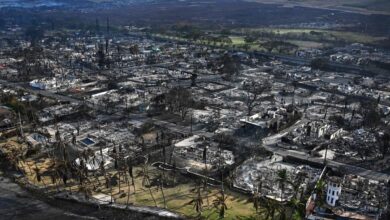2022’s biggest climate disasters – and why we must remember them

Wildfires tearing through the London suburbs. One-third of Pakistan underwater. Drought-linked famine looming for tens of millions of people in East Africa. Billions of dollars in damage from a “500-year” hurricane that smacked into Florida.
The year 2022 brought disaster after disaster across the planet with scientists increasingly able to point to the climate crisis as the root cause.
Here, The Independent looks back at some of the most erratic and devastating events being driven by humanity’s continued reliance on burning fossil fuels:
This summer’s record-breaking monsoon flooding wreaked havoc across Pakistan, plunging one-third of the country underwater. The rising torrents killed more than 1,700 people, including nearly 500 children, and left 13,000 injured. Nearly eight million citizens were displaced and $40bn in damages done to 8,000 miles of roads, 439 bridges and 2.3 million houses.
The climate crisis intensified Pakistan’s monsoon rains by 50-75 per cent, World Weather Attribution (WWA) subsequently discovered. WWA, an international team of climate scientists who volunteer their expertise, frequently respond to this pressing question: To what extent was an extreme event influenced by climate change?
Pakistan’s summer floods have spawned myriad crises. The country is facing a massive public health disaster as water-borne diseases spread, leaving large numbers of women and girls with urinary tract infections, reproductive issues and pregnancy complications. The country is also grappling with food shortages after the developing country’s agricultural belt under water.
Severe flooding also impacted West and Central Africa and killed hundreds of people. Some 3.4 million were forced to leave their homes in Nigeria, Chad, Niger, Burkina Faso, Mali and Cameroon as farmlands, homes and infrastructure went under water.
More than 40 people, including four siblings under eight, were also killed when flash flooding struck rural parts of the US state of Kentucky this summer.
Ethiopia, Somalia and Kenya are facing their longest-running drought in 40 years after the rainy season failed to arrive for the fifth consecutive year.
The exceptional drought highlights the region’s vulnerability to climate-related shocks, which are expected to intensify because of the climate crisis.
Millions are facing starvation after lack of water caused crop failures and killed nearly 10 million livestock, in areas where small farms and a pastoral way of life are commonplace. In Kenya alone, the government estimates the economic cost of livestock loss at more than $1.5bn.
Across the Horn of Africa, at least 36 million people will be affected, with the majority in Ethiopa, but nearly eight million in Somalia and five million in Kenya also impacted . This includes more than nine million women of reproductive age who face dangers to their health and aggravated risks of gender-based violence due to the drought.
“We fled hunger, but hunger followed us here. I tried to find help, but it was too late for Ahmed. He took two last breaths and that was it. He didn’t even cry,” Mahupo Ali, a mother of three, told Save the Children in Baidoa, Somalia, after giving birth in a camp for displaced people but was unable to produce enough milk to feed her baby boy.
Even without a famine being officially declared in Somalia, deaths during this drought could be as high as in the 2011 famine, the charity reported.
More than 230 children have been buried in a single graveyard in Baidoa after dying from malnutrition. About five million children are acutely malnourished in drought-affected areas.
The American flag flies amid debris along a roadside on Estero Island, which was heavily damaged by Hurricane Ian in Fort Myers Beach, Florida
And an estimated 1.3 million pregnant and lactating women are acutely malnourished, many who have sacrificed their own well-being and nutrition to care for their families.
Hurricane Ian slammed into Florida at near Category-5 status in September after undergoing “rapid intensification”. The phenomenon – which sees tropical cyclones super-charged over a short period of time – is becoming more common as the climate crisis makes oceans hotter.
Ian made landfall in the state’s southwest with winds that sheared off roofs and coastal surge as high as a two-storey building in places.
“We’ve never seen storm surge of this magnitude,” Florida Governor Ron DeSantis said, describing the storm as “basically a 500-year flooding event”.
Buney Aayow Ibrahim, a Somali woman affected by the worsening drought due to failed rainy seasons, holds her child Sadia Salas Abdi, 3, as her grandmother Habiba Osman looks on, outside their makeshift shelter at the Alla Futo camp for internally displaced people, in the outskirts of Mogadishu
A man looks out from the Bund promenade along the Huangpu River as decorative lights are switched off as a measure to save energy in Shanghai





